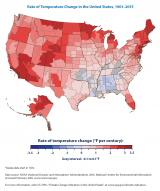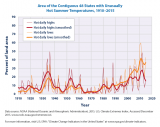Climate Change and Heat Islands
On this page:
- Harsher Heat Waves
- Harmful Health Impacts
- Electricity Impacts
- The Benefits of Managing the Heat Island Effect
Climate change and the heat island effect interact in two important ways. First, our warming climate will increase already higher temperatures in heat island areas. Second, cooling strategies to reduce heat islands can help communities adapt to the impacts of climate change as well as lower the greenhouse gas emissions that cause climate change .
Harsher Heat Waves
Climate change leads to higher temperatures and longer, more severe, and more frequent heat waves. Urban areas already suffering from the heat island effect will bear the brunt of these harsher heat events.
Over the last 20 years, extreme summer heat has become more frequent across the contiguous 48 states, 1 with western regions setting records for numbers of events in the 2000s. 2 The interaction of rising temperatures, more heat waves, and the heat island effect will be increasingly harmful to people’s health and the air and water quality in our communities.
Harmful Health Impacts
When people are exposed to extreme heat, they can suffer from potentially deadly illnesses, such as heat exhaustion and heat stroke. Older adults, young children, low-income populations, people who work outdoors, and people in poor health are the most vulnerable to these impacts. Many people die from extreme heat. Between 1979 and 2010, heat was recorded as the underlying or contributing cause of death for nearly 8,000 Americans, peaking in 2006, a year of widespread heat waves and the second-hottest year on record in the contiguous 48 states. 1 The actual number of heat-related deaths may be much higher since the cause of death may not be reported as "heat-related" on death certificates.
Older adults are among the most vulnerable to extreme heat events. Many physiological, psychological, and socioeconomic factors contribute to this danger. Older adults are more likely to be in poor health, to be less mobile and more isolated, to be more sensitive to high heat, and to live on reduced incomes. 3
Young children are another group at risk of illness. Children tend to be more susceptible to extreme heat due to their small size and other characteristics. Children’s more rapid breathing rates relative to body size, time spent outdoors, and their developing respiratory systems raise their chances of aggravated asthma and other lung diseases caused by ozone air pollution and smog, which usually increases during heat waves. 4
Low-income populations can also be in danger of heat-related illnesses due to poor housing conditions, including lack of air conditioning and small living spaces, and inadequate resources to find alternative shelter during a heat wave. 4
People who spend their working hours outdoors are more prone to conditions such as heat exhaustion and heat stroke. They have higher exposures to ozone air pollution and heat stress, especially if work tasks involve heavy exertion.
People in poor health, including people with chronic conditions, disabilities or mobility constraints, and those taking certain medications, are also vulnerable to extreme temperatures. People with diabetes, physical impairments, and cognitive deficits are especially at risk during heat waves. 4
Electricity Impacts
In a warmer climate, Americans would use more electricity for air conditioning and less fuel for heating. If the nation's climate warms by 1.8°F (1°C), the demand for electricity used for cooling would increase by about 5-20%, while the demand for electricity used for heating would decrease by 3-15%. 5 Current evidence shows that in recent decades heating demand in the United States has generally decreased in the north and west, and cooling demand has generally increased in the southwest. 1 With the heat island effect compounding the warming from climate change, cities will likely require more electricity for air conditioning than surrounding areas.
The need for electricity, especially during heat waves, could stress our electricity infrastructure, resulting in more frequent or prolonged power outages, or a need for new system investments. 5 For example, based on a 6.3 to 9°F temperature increase, climate change could increase the need for additional generating capacity by roughly 10-20% by 2050. This would cost hundreds of billions of dollars. 6
Using more electricity and adding more capacity for its production will likely result in more emissions of air pollution and the greenhouse gases that cause climate change. Therefore, any efforts to reduce the heat island effect can also help mitigate climate change.
The Benefits of Managing the Heat Island Effect
Efforts to reduce the heat island effect, mitigate climate change, and adapt to climate change impacts often interact with each other in complex ways.
Most efforts to cool urban heat islands produce many benefits, including lower temperatures, electricity demand, air pollution, greenhouse gases, and harmful health impacts. Efforts to reduce the heat island effect thus also help to address climate change and improve air quality. In addition, these same measures can help communities become more resilient to many of the damaging impacts of climate change. For example:
- Planting shade trees or installing green or cool roofs can lower surface and air temperatures while reducing the amount of energy needed to cool buildings, resulting in improved reliability of the electric system, particularly during extreme weather events.
- Green roofs and some types of cool pavements can diminish heat islands while also reducing stormwater runoff, and limiting flooding risks during heavy rainstorms. In the same way, increasing the tree canopy helps protect against high winds, erosion, and flooding.
- Smart growth can cool urban areas, while also decreasing the need for fossil fuel-powered transportation and improving access to cooling centers.
In some cases, climate change adaptation or mitigation strategies might conflict with heat island reduction efforts. For example, any adaptation effort that results in replacement of vegetative cover with impermeable surfaces, such as hardening coastal infrastructure to protect against rising sea levels, could increase the heat island effect. However, communities can help minimize such negative outcomes by incorporating cooling strategies into overall climate action planning (mitigation and adaptation).
- U.S. Environmental Protection Agency (2014). Climate change indicators in the United States, 2014. Third edition. EPA 430-R-14-004.
- USGCRP (2014). National Climate Assessment. National Climate Assessment and Development Advisory Committee, United States Global Change Research Program.
- Gamble, J.L., B. J. Hurley, P.A. Schultz, W.S. Jaglom, N. Krishnan, and M. Harris (2013). Climate Change and Older Americans: State of the Science. Environmental Health Perspectives 121(1): 15-22.
- CCSP (2008). Analyses of the effects of global change on human health and welfare and human systems. A Report by the U.S. Climate Change Science Program and the Subcommittee on Global Change Research. [Gamble, J.L. (ed.), K.L. Ebi, F.G. Sussman, T.J. Wilbanks (Authors)]. U.S. Environmental Protection Agency, Washington, DC, USA.
- USGCRP (2009). Global Climate Change Impacts in the United States. Karl, T.R., J.M. Melillo, and T.C. Peterson (eds.). United States Global Change Research Program. Cambridge University Press, New York, NY, USA.
- CCSP (2007). Effects of Climate Change on Energy Production and Use in the United States. A Report by the U.S. Climate Change Science Program and the subcommittee on Global change Research. Wilbanks, T.J., V. Bhatt, D.E. Bilello, S.R. Bull, J. Ekmann, W.C. Horak, Y.J. Huang, M.D. Levine, M.J. Sale, D.K. Schmalzer, and M.J. Scott. Department of Energy, Office of Biological & Environmental Research, Washington, DC, USA.


